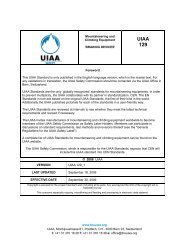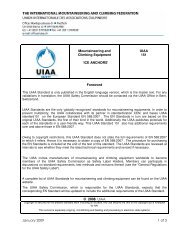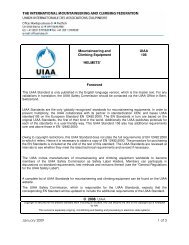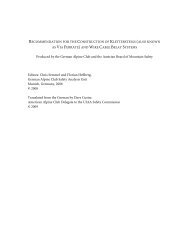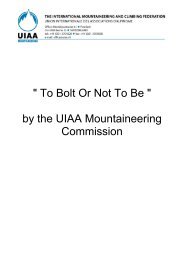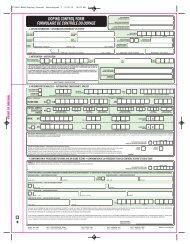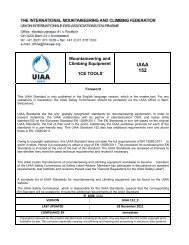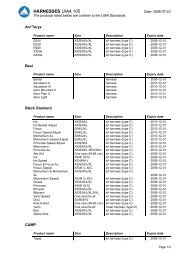Doping Control Leaflet - World Anti-Doping Agency
Doping Control Leaflet - World Anti-Doping Agency
Doping Control Leaflet - World Anti-Doping Agency
You also want an ePaper? Increase the reach of your titles
YUMPU automatically turns print PDFs into web optimized ePapers that Google loves.
<strong>Doping</strong> <strong>Control</strong> Flyer_ENG:<strong>Doping</strong> <strong>Control</strong> Flyer_ENG.qxd 14/01/2009 5:06 PM Page 1Votre logo ici<strong>Doping</strong> <strong>Control</strong>1IntroductionThe <strong>World</strong> <strong>Anti</strong>-<strong>Doping</strong> <strong>Agency</strong> (WADA) was established in 1999 as a jointresponse between the Olympic Movement and public authorities to combatdoping in sport. WADA's mission is to promote, coordinate and monitor on aninternational basis the fight against doping in all its forms.Athlete testing, or doping control, is an essential programme in both promotingand protecting doping-free sport.<strong>World</strong>wide doping controls are carried out in accordance with the <strong>World</strong> <strong>Anti</strong>-<strong>Doping</strong> Code and the International Standard for Testing, developed by WADA inconsultation with its stakeholders.Athletes who compete at the international and national level may be testedanytime, anywhere. The test can be conducted at a competition or away from acompetition situation, such as at an athlete's home or training venue, with noadvance notice. Urine and/or blood may be collected. Specially trained andaccredited doping control personnel carry out all tests.<strong>Doping</strong> Contol: Step-by-StepNotificationA <strong>Doping</strong> <strong>Control</strong> Officer (DCO) orChaperone will notify the athlete ofhis or her selection for dopingcontrol. In general, this notification isdone in person. The official identificationand the authority underwhich the sample collection is to beconducted are shown to the athlete.Athlete SelectionThe selection of athletes is based on the requirementsof the responsible <strong>Anti</strong>-<strong>Doping</strong> Organisation (ADO). Theselection may occur in three ways: random, based onestablished criteria (e.g. finishing position), or targeted.The DCO or Chaperone will inform the athlete of his or her rights and responsibilities,including the right to have a representative present throughout the entireprocess. The athlete will be asked to sign the form confirming that he or she hasbeen notified for doping control.For a minor or an athlete with a disability, a third party may be notified as well.www.wada-ama.org26Reporting to the<strong>Doping</strong> <strong>Control</strong> StationThe athlete should report to the dopingcontrol station immediately followingnotification. The DCO may allow theathlete to delay reporting to the doping control station for activities such as a pressconference or the completion of a training session; however the athlete will beaccompanied by a DCO or a Chaperone from the time of notification until thecompletion of the sample collection process.The athlete will be asked to provide photo identification and be given theopportunity to hydrate. Athletes are responsible for what they decide to drink.They may drink their own beverage or choose from a selection of sealed, caffeinefree,non-alcoholic beverages.4Provision of SampleSelection of Collection VesselThe athlete is given a choice of individuallysealed collection vessels and selects one.The athlete verifies that the equipment isintact and has not been tampered with. Theathlete should maintain control of thecollection vessel at all times.Only the athlete and a doping control official of the same genderare permitted in the washroom during the provision of thesample. Minors or athletes with a disability may also have theirrepresentative present in the washroom. However thisrepresentative is not permitted to view the provision of thesample. The objective here is to ensure that the doping controlofficial is observing the sample provision correctly.Athletes are required to remove any clothing from the knees to mid-chest andfrom the hands to the elbows. This provides the doping control official with adirect observation of the urine leaving the athlete's body. These provisions aremeant to ensure that it is the athlete's own urine and help prevent possiblemanipulation of the urine sample.The Athletes maintain control of their samples at all times during the process,unless assistance is required due to an athlete's disability.Volume of Urine5The DCO shall ensure that an athlete infull view shall provide no less than 90mlof urine. If the amount of urine does not meet the minimumrequirements, the athlete will proceed with the Partial SampleProcess (outlined at the end of this leaflet).www.wada-ama.org3
<strong>Doping</strong> <strong>Control</strong> Flyer_ENG:<strong>Doping</strong> <strong>Control</strong> Flyer_ENG.qxd 14/01/2009 5:06 PM Page 47Splitting the SampleIf the athlete has provided the required volume of urine,the athlete will be given a choice of individually sealedsample collection kits, from which to choose one. Theathlete verifies that the equipment is intact and has notbeen tampered with. The athlete will open the kit andconfirm that the sample code numbers on the bottles, thelids and the container all match.The athlete splits the sample, pouring the urinehim or herself, unless assistance is required dueto an athlete's disability.Selection of the Sample Collection KitThe athlete pours the required volume of urineinto the "B" bottle. Then the remaining urine ispoured into the "A" bottle. The athlete will beasked to leave a small amount of urine in thecollection vessel so the <strong>Doping</strong> <strong>Control</strong> Officer can measure the specific gravity ofthe sample according to the relevant laboratory guidelines.9Measuring Specific GravityThe DCO measures the specific gravity using theresidual urine left in the collection vessel. The valuesare recorded on the doping control form. If the sampledoes not meet the specific gravity requirements, theathlete may be asked to provide additional samples asrequired by the <strong>Anti</strong>-<strong>Doping</strong> Organization.Sealing the SamplesThe athlete seals the "A" and "B" bottles.The athlete representative and the dopingcontrol officer should verify that the bottlesare sealed properly.10812Completion of <strong>Doping</strong> <strong>Control</strong> FormThe athlete is asked to provide information aboutany prescription/non-prescription medications orsupplements he or she has taken recently. Thesemedications are recorded on the doping controlform. The athlete has the right to note commentsand concerns regarding the conduct of the dopingcontrol session. The athlete should confirm that allof the information on the doping control form iscorrect, including the sample code number.The person who witnessed the passing of the sample, the athlete representative,the <strong>Doping</strong> <strong>Control</strong> Officer and the athlete will sign the doping control form at theend of the sample collection process.The athlete is given a copy of the doping control form.11The laboratory copy of the doping control form does not contain any informationthat could identify the athlete.The Laboratory ProcessSamples are packaged for shipping toensure that the security of the sample istracked. The samples are sent to aWADA-accredited laboratory. Thelaboratory will inspect the samples upontheir arrival to ensure there is noevidence of tampering.The WADA-accredited laboratory will adhere to the International Standard forLaboratories when processing a sample, ensuring the chain of custody ismaintained at all times.The "A" sample will be analyzed for substances on the Prohibited List. The "B"sample is securely stored at the laboratory and may be used to confirm anAdverse Analytical Finding from the "A" sample.The laboratory will report the results of the sample analysis to the responsible<strong>Anti</strong>-<strong>Doping</strong> Organization and WADA.Partial Sample ProcessCombining the SampleSealing the Partial SampleWhen less than 90ml of urine is provided, theathlete will proceed with the partial sampleprocess until the required amount of volume isprovided. During this process the partialsample(s) will be sealed and secured using thepartial sample equipment.The sealed partial sample should remain in thecontrol of either the athlete or the DCO. Whilewaiting to provide additional sample(s), theathlete shall remain under continuous observation and be given the opportunity tohydrate. When the athlete is ready to provide another sample, the process ofsample collection continues as described before.When the required amount of urine has been provided, the athlete will select anew, sealed collection vessel and combine his or her samples, beginning with thefirst partial sample provided and each subsequent partial sample until thedesired volume is reached. The sample is then sealed according to the stepsoutlined before.1 2 3Final NotesThe information and the materials shown in this booklet are meant to serve as aguide to the urine sample collection process; it does not reflect an opinion on thetype of equipment to be used.Testing worldwide should follow the principles of these guidelines, although theremay be slight variations in the procedures adopted by different anti-dopingorganizations, which will not affect the integrity of the process.For further information, please contact your National <strong>Anti</strong>-<strong>Doping</strong> Organization, orInternational or National Federation. You may also visit our Web site atwww.wada-ama.org.www.wada-ama.orgwww.wada-ama.orgwww.wada-ama.orgProduced in collaboration with theSwiss Federal Office of Sport,Magglingen (Switzerland)






